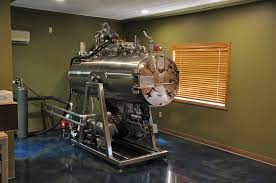The Battle for Aquamation
 There is a battle being waged over the human disposition method called “aquamation”, also known as alkaline hydrolysis or flameless cremation. But, most of us are just too busy or are comfortable with disposition in the form of earth burial or cremation to really notice it.
There is a battle being waged over the human disposition method called “aquamation”, also known as alkaline hydrolysis or flameless cremation. But, most of us are just too busy or are comfortable with disposition in the form of earth burial or cremation to really notice it.
I find it interesting in a world where everything seems to be “Green” that more people are not talking about aquamation. According to this article from Time, “aquamation . . remains rare in the United States and faces powerful opposition as states try, one-by-one, to make it legal.”
Proponents of aquamation say that the environmental impact of the process should outweigh any other arguments that people have about its use. Again, according to the Time article, “each year burials in the U.S. use about 4.3 million gallons of embalming fluid, 20 million feet of wood, 1.6 million tons of concrete, and 64,500 tons of steel. .and transporting of those materials produce 250 lbs. of carbon emissions annually, while fire cremation produces 1.74 billion pounds of carbon dioxide emissions.” In contrast, according to the same article, “aquamation uses about 90% less energy than a flame-based cremation and releases no harmful greenhouse gas emissions.”
Finally, an aquamation quoted in the article was billed at only $1,500 whereas a direct cremation was comparable and the NFDA national average price for a funeral with burial and vault is listed at $9,420. So, price should not be an issue.
Yet of about 1.8 million cremation type dispositions done in the United States in 2020, only about 18,000 were of the “flameless” cremation (aquamation) variety. So, where is the hang-up?
According to CANA (Cremation Association of North America) since 2011 when the process was first used by United States funeral homes on human cadavers, about 20 states have approved the process for human disposition with about nine more having pending legislation.
Again, according to the Time article, the states with pending legislation “face powerful opposition from the Catholic Church and cemetery groups.”
Here again is a quote from the Time article on that point, “In written testimony in April 2021, the Wisconsin Catholic Conference said the manner of discharge was disrespectful, largely because “wastewater does not honor the sacredness of the body.” Similar arguments made by the Diocese of Manchester, the Catholic Church in New Hampshire, stymied efforts in that state in 2014. “Flushing away human remains” dishonors the dead, says Robert Dunn Jr., the diocese’s public policy director. “The issue of disrespect for human remains is something that outweighs any of the other arguments that might be made in favor of this.”
It’s estimated that the water used in aquamation is about 300 gallons — about the same amount an average household uses in one day. A spokesman for a municipal water facility mentions that is a very small amount in a city where over 70 million gallons are discharged daily. Nonetheless, it is not the amount, but the thought of releasing that effluent into a municipal system that creates the barrier with the Catholic Church.
Funeral Director Daily take: I’m a believer in alkaline hydrolysis, just as I am in natural organic reduction (human composting). Even though neither of those processes is what I would choose at this time in my life, I find nothing wrong with the methods for those that want to use them.

Tom Anderson
Funeral Director Daily
I also understand the Roman Catholic Church dioceses mentioned in the article and can see their point of view. I’m a Christian Lutheran who understands the sanctity of the body — and church elders smarter than I have to reason with this process. The Catholic Church eventually accepted cremation of the body. . . .will they accept aquamation in time?
In the meantime, I think market forces will drive these (natural organic reduction and alkaline hydrolysis) methods of disposition into the mainstream. And, I think the environmental consciousness of the next generations will lead that movement.
I don’t believe that there is anybody on the planet against renewable energy. However, how we make that transition — overnight and forced by government or with market forces and over-time — seems to be where the argument is.
And, as we mentioned with the green funeral movement in a column last week, infrastructure and being able to do the services is a must before these methods move into the mainstream. In the case of alkaline hydrolysis that infrastructure is the machines, much like flame cremation machines, that are readily available in our nation’s funeral homes. It is my understanding that as of today there are about 3,300 licensed flame crematories in the United States and less than 40 licensed human alkaline hydrolysis machines. Funeral homes will need to invest in this technology as aquamation becomes more popular.
More news from the world of Death Care:
- Service Corporation International partners with Donate Life America. Yahoo Finance
- Ballot proposal would allow city to sell vacant cemetery land. Lansing City Pulse (MI)
Enter your e-mail below to join the 2,640 others who receive Funeral Director Daily articles daily:





















I would like to thank you in advance for your time. I am considering Alkaline Hydrolysis as an option upon my passing. I would appreciate so very much your providing me the name of a CANA entity in Minneapolis, MN that I may want to consider for this type of cremation. May I also inquire as to what the cost is for this type of service?
Fireless Cremation’s alkaline hydrolysis 2.0 systems for humans and pets return 100% of the deceased to the earth or sea – not the sewer. Our new chemical process uses just 60% of the weight of the decedent in water – not 300 gallons. A 200-pound decedent would use 14 gallons of water.
Jeff Edwards, the 1st funeral director to own and operate an alkaline hydrolysis system, said we have solved all the problems that have plagued alkaline hydrolysis. He volunteered his time at our ICCFA booth to share the good news.
The battle for aquamation has been for a manufacturer to offer systems that are safe (don’t explode), fast, affordable, complete the dissolution process ( no brains, marrow, or tissue remaining), and do not rely on wastewater treatment centers to deal with the fats in the effluent. The battle for aquamation is now easier for funeral operators and legislators, http://www.firelesscremation.com manfactures systems that work!
Aquamation is a trade name by a company that offers alkaline hydrolysis, just like Resomation, and Green Cremation. When you address the technology and not a company it should be called Natural Water Cremation or Alkaline Hydrolysis.
The earths crust is made up of 2.4% potassium, we double that, and add 95% water to accelerate what happens naturally in the earth over days and months. The gentle process is heated to 302F and the cremation is finished 3-5 hours later, depending on the size of the individual.
The effluent from the process is completely sterile and contains no DNA, far better than what the Catholic church places in the waste stream with embalming chemicals, infectious diseases, and pharmaceutical drugs. UCLA has 30 tests from the city of Los Angeles to prove it. Sister Renee Mirkes from the Omaha Diocese visited the Mayo Clinic and wrote an article that is published on AH and in the article it states that this is her method of disposition.
21 states have approved the use of AH and Hawaii will become the 22nd next month.
I could go on and on……. Institutions like Mayo Clinic and UCLA don’t implement this technology without doing their research and due diligence. Follow the science and feel free to reach out to me at any time.